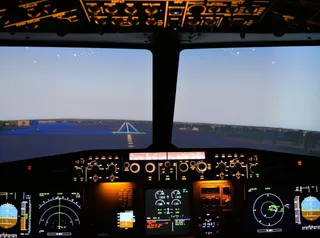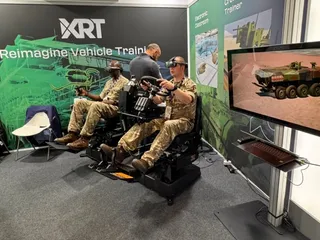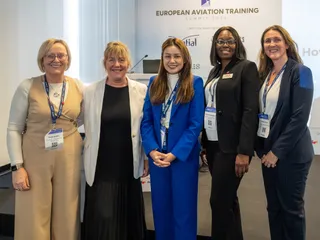CBTA/EBT implementation in Europe
Contact Our Team
For more information about how Halldale can add value to your marketing and promotional campaigns or to discuss event exhibitor and sponsorship opportunities, contact our team to find out more
The Americas -
holly.foster@halldale.com
Rest of World -
jeremy@halldale.com

The aviation training landscape in Europe is being increasingly characterised by competency-based training and assessment (CBTA) and evidence-based training (EBT), which are reshaping how pilots and cabin crew are being prepared for their roles.
While the European Union Aviation Safety Agency (EASA) has established a regulatory framework for these approaches, implementation across Europe remains varied. Nevertheless, the CBTA/EBT shift increasingly marks a cultural change in how the industry approaches safety, performance assessment, and professional development.
The move from traditional task-based training to competency-based methodologies demands significant investment, especially in instructor development, but the perspective is remarkable: Improved crew performance and enhanced safety outcomes through continuous improvement.
This article examines the current state of CBTA/EBT implementation in Europe, exploring the regulatory environment, methodological shifts, and emerging results that are reframing crew training.
Regulatory environment
The EASA framework has established a structured and transparent basis for CBTA and EBT in the European Union, observes Jörg Schönfeld, head of training at Lufthansa Aviation Training.
“The model is characterised by precision and regulatory consistency. Implementation requires a multi-year process that includes data integration, instructor qualification, and quality assurance. The EASA EBT framework guidelines and the IATA CBTA implementation guide ensure a harmonised and globally recognised approach”, he says.
According to Peter Hogston, global head of training at Acron Aviation, both within and outside EASA, have adopted different approaches to implementing CBTA and EBT.
“Commercial air transport operators have developed individual programs to meet their operational needs and training regimes. Major manufacturers have developed programmes that support their customers in developing CBTA/EBT. It is evident that several third-country (non-EASA) operators have requested support for developing their programs using EASA as a basic template”, he says.
“Some operators will not implement CBTA because the alternative training and qualification program (ATQP) is tailored to their specific operations. There are no shortcuts to implementing effective programmes, manuals, documentation, learning management systems, and the development of instructors, assessors (examiners), and crews represent the challenges operators face when undertaking this cultural shift in training and operational delivery."
In relation to cabin crew training, not much has been defined so far, notes Raghoonundun (Birdy) Gunputh, senior manager safety training/policies, standards & legal requirements at Lufthansa Aviation Training.
“EASA has adopted a hybrid approach incorporating CBTA principles into its guidelines for cabin crew initial training in 2022. We used these guidelines along with ICAO Document 10002 to begin implementing CBTA principles in cabin crew training. Compared to the United States, the FAA has already implemented the AQP, which follows a similar training philosophy. To begin implementing CBTA, we first had to modify the training approach accordingly and train instructors to understand this new philosophy and become accustomed to its principles”, he affirms.
“After implementing CBTA as part of EASA’s new cabin crew initial training, we estimate that it will likely take at least three years of practice before those providing the training fully master it. Additionally, it is necessary to invest in the right performance monitoring technology that reflects individual and entire crew performance, to identify strengths and weaknesses and enable corrective action”.
From task-based to competency-based
The shift from task-based to competency-based assessment has redefined the role of the instructor, according to Schönfeld.
“Instructors now act more as observers and behavioural facilitators than as procedural examiners. Calibration sessions, the use of behavioural indicators, and structured debriefing have proven to be the most effective methods for ensuring consistent performance assessment, both technical and non-technical”, he says.
CBTA and EBT rely on instructors and assessors to deliver appropriate training and assessment, and the fundamental change involves recording observable behaviours (OB) to identify the root cause of a pilot’s failure to develop or difficulty maintaining appropriate skills at a given point in the flight, Hogston affirms.
“Several tools on the market support recording OBs and scores for pilots during training or assessment. Depending on the training delivery phase, the number of assessed competencies can be reduced to allow for focus on key competencies. Instructors/assessors are assessed using a specific set of competencies designed to develop the individual and achieve the desired standard”, he says.
“Instructor-assessor competencies (IEC) are a unique set of competencies that include the desired OBs to measure an effective CBTA instructor/assessor. IEC tables are produced by IATA with a set of five key competencies that focus on instructor/assessor performance and their relationship with the trainee and the training environment”.
Testing knowledge or completing a task is no longer enough to predict trainee performance, according to Birdy Gunputh.
“The instructor’s role is becoming that of a facilitator, and the examiner’s demands are more demanding, as we must focus on the various competencies that influence trainee performance. All of this is completely different from a simple check-box system. We adopted the ‘observe, record, classify, assess/evaluate’ (ORCA) process and applied the VENN model to assess trainee competencies during simulated cabin crew exercises”, he said.
Training methods in CBTA
Simulator-based training remains the fundamental platform within CBTA and EBT, notes Schönfeld. “Its value lies in the realism of the scenarios and data-driven feedback. Each training organisation adapts its competency framework to its specific operational context, while maintaining full alignment with EASA’s core regulations”, he says.
Currently, high-performance fixed-base devices are replacing traditional full flight simulator (FFS), while an increasing number of operators are considering virtual reality (VR) and mixed reality (MR) devices/systems to replace standard training devices, Hogston points out.
“With regulations still in development and CBTA and EBT not fully mandated by several competent authorities, operators will limit the scope of alternative training systems”, he says.
“However, it is not impossible for cognitive skills such as problem solving and decision making to be trained or assessed in an escape room or other specialised scenario/device”
For cabin crews, there is a trend towards a shift from less instructional to more experiential training, in which trainees experience a situation and must demonstrate their ability to apply a procedure or skill, even in more complex situations that reflect real-life scenarios, observes Birdy Gunputh.
“After acquiring the necessary knowledge, trainees have the opportunity to develop skills and demonstrate their abilities in simulated scenario-based exercises conducted in cabin simulators”, he says.
“These exercises are conducted in a team setting, with appropriate interaction with other trainees to solve a problem in a simulated practical work environment. Additionally, we also offer individual exercises to demonstrate each trainee’ skills for a specific task in each situation, such as applying procedures”.
Lufthansa Aviation Training uses regulatory requirements for cabin crew training and breaks them down according to the training purpose to ensure compliance.
“After a thorough analysis of the purpose, we define the training objectives and use the ICAO competency framework to create an adapted competency model for the relevant training session, with the key performance criteria associated with that session. This is then used to ensure the training objectives of the session are met and, ultimately, the assessment standard established by the operator”, says Gunputh.
Trainee performance improvements
With EBT and CBTA, Lufthansa Aviation Training aims to achieve measurable improvements in behavioural reliability and overall training effectiveness. “The goal is to enable trainees to acquire operational skills more consistently and timely”, says Schönfeld.
The topic of trainee performance improvement is strictly related the multi-crew pilot license (MPL) concept, which entails a competency-based system focussed on operational ethics, standard operating procedures, and the specific types of selected operators, points out Hogston.
“Results of MPL implementation include reduced line training time, improved performance during traditional licence proficiency check (LPC) and operator proficiency check (OPC) events, and improved performance during command refresher courses”, he says.
While for cabin crew training Lufthansa Aviation Training is still in the implementation phase, the principles of CBTA are already proving more promising than traditional training, according to Gunputh.
“This is because we focus on achieving a performance level that best prepares cabin crews for any eventuality on board, rather than simply meeting quantitative requirements, such as training hours culminating in an exam. Some training courses conducted confirm that the approach supports the development of skills to best prepare trainees for their roles”, he says.
“Because CBTA does not use a passive system with numerous hours of theory, but rather a blended approach, we see efficiency in achieving the target performance level during training. Trainees are more engaged in their respective training sessions, and competencies are clearly defined so trainees can target them correctly, thus achieving the set standards more effectively and in less time”.
Competency-based training should be viewed beyond the concept of training delivery, says Hogston. “It is an ethics designed to improve the skills and knowledge of pilots who have an appropriate attitude toward their profession and a willingness to learn through their individual and unique behaviours. CBTA and EBT is more about the professional pilot’s ownership of skills and how to continuously improve crews operating a given fleet, rather than the development of a new training regime”, he says.
Summing up
The implementation of CBTA and EBT in European civil aviation training is going beyond procedural updates, it is reimagining how the industry develops and assesses aviation professionals. This transformation demands substantial commitment: multi-year implementation timelines, comprehensive instructor retraining, and a cultural embrace of continuous improvement over checkbox compliance.
Operators must carefully adapt competency frameworks to their specific operational contexts while maintaining regulatory alignment. The redefinition of instructors and examiners as behavioural facilitators and observers rather than procedural checkers requires a new professional mindset.
The early indicators, however, are promising. In addition, as operators gain experience and technology continues to evolve, from high-performance fixed-base devices to virtual and mixed reality systems, the efficiency and effectiveness of these approaches will likely continue to improve.


